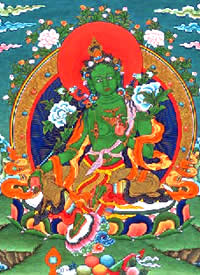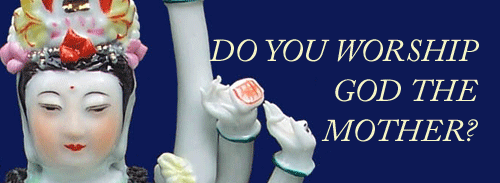White Tara and Green Tara
Two Streams of Divine Love
The two main forms of the Goddess Tara are Green Tara and White Tara. Actually there are said to be twenty-one Taras (which would correspond naturally to the Seven Great Janyati manifest in each of the three worlds), but the Green and White versions of the Goddess are by far the most important and form a Divine Duality.To one familiar with the Déanic point of view and the Filianic Creed, the characteristics of the two Taras have an immediate and clear resonance.
White Tara, with Her full-open lotus, is associated with Day; Green Tara, with Her half-open lotus, is associated with Night. White Tara is serene; Green Tara is active. White Tara represents the Motherly aspect of Divine Compassion, while Green Tara is represented as a perfect young girl (she is considered to be eternally sixteen years old). The primary function of Green Tara is as the Saviouress.
Clearly we have here the Mother and Daughter streams of Divine Love. The serene Solar Mother of the World (White Tara is called the Mother of All Buddhas) and the lunar Daughter who descends into the flux of activity (samsara) to save Her creatures.
In Tibetan symbolism, green is considered to be the colour that contains all other colours, while white is the pure non-colour from which all colours have their origin.
Naturally the Two Taras are One, just as the Mother and Daughter are one and the same God.
The Two Taras show us that the Mother and Daughter streams of Divine Femininity are always present, even when they are not specifically named as such.
It may be asked: "If White Tara and Green Tara are Mother and Daughter, where is the Dark Mother?" Within the Buddhist system, the Dark Mother is the Void (shunya) from which all things arise, and whereto they must ultimately return. Shunya is also Nirvana, which appears like extinction from the human point of view, but is actually the return to the fullness of our Divine Origin.
The following mediaeval hymn to Green Tara invokes the Void in its first line. The Daughter is rooted in the ultimate Reality, while She exists, for our salvation, within the duality of being represented by Wisdom (Mother) and Method (Daughter). The same duality is also signified by Her "two-armed" nature, while their rootedness in the ultimate Oneness is signified by the term "one-faced".
We hope you will enjoy these lovely words:
Hymn to Green Tara
Enthroned upon the lotus, signifying realization of the Void,
Thou Art the emerald-hued, one-faced and two-armed Lady
Ever in youth's full bloom, the right leg out, the left drawn in,
Showing the union of Wisdom and Method.
Homage to Thee!
Like the outstretched branch of the heavenly turquoise tree,
Thy supple right hand makes the boon-granting gesture,
Inviting the wise to a feast of supreme accomplishments,
As if to an banquet.
Homage to Thee!
Thy left hand gives us refuge, showing the Three Jewels;
It says, "All you who look upon a hundred dangers,
Be not afraid, for I shall swiftly save you!"
Homage to Thee!
Both hands announce with blue utpala flowers,
"Souls in Samsara! Cling not to worldly pleasures.
Enter the Holy City of Liberation!"
Thy flowers are sweet goads, spurring us to effort.
Homage to Thee!

This beautiful hymn is a devotion to the Daughter as Green Tara and also to the Mother and the Dark Mother. We have seen this in the first verse, and we may indeed see the next three verses as depicting the Serene right hand of the Mother, the Active left hand of the Daughter and the final Union beyond all dualities.
It does not matter whether we see them as separate or as aspects of our One Mother God, for both perspectives are equally true. Saying this hymn prayerfully we shall find in it whatever our dear Mother wishes us to learn from it at this stage in our journey.
More important than any intellectual thealogy is the direct appeal to Dea as our loving Savior Who rescues us from dangers and welcomes us to our Divine Home.
The name Tara, as we have seen, means Star. A secondary meaning is "Savior" in the specific sense of "She who carries us across the waters". The waters are the ever-rolling waves of samsara, and this appellation of Tara is precisely the same as the sense in which the Devi Gita hails Dea as "the Barque of Swift Crossing".
Wherever we find Her, Dea is the loving Mother who carries us over the turbulent waters of samsaric existence; and whether we call upon Her as Green Tara, White Tara, Quan Yin, Lady Mary or Sri Devi, She is always there to love us and bring us safe to shore.
See also:
The Goddess Tara
Rangjung: The miraculous self-emerging Images of Tara
Send Questions or Comments on White Tara and Green Tara
Chapel of Our Mother God Homepage
All written material on this site is copyright. Should you wish to reproduce any portion please contact us for permission.
The Many Names of Dea
Gospel of Our Mother God
The Gospel of Our Mother God is a collection of inspirational texts, prayers and daily inspiration for the Mother-Faith devotee or household.
The Feminine Universe
The Other Philosophy
Everything you have ever heard comes out of the patriarchal world-view. Its materialism, its religion, even its feminism. Here is the other way of seeing the world; the natural way: the way that everyone saw things before patriarchy and will again when patriarchy is long forgotten.



